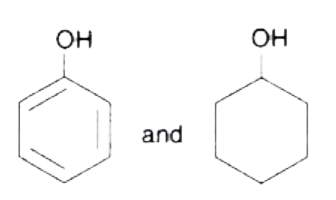Give a chemical test to distinguish between the following:
Ammonium chloride and sodium chloride.
To distinguish between ammonium chloride (NH4Cl) and sodium chloride (NaCl), we can perform a simple chemical test based on their behavior when heated.
1. Gather Materials: Obtain two test tubes, one containing ammonium chloride (NH4Cl) and the other containing sodium chloride (NaCl). You will also need a heat source (like a Bunsen burner) and a spatula.
2. Preparation: Label the test tubes to avoid confusion. For example, label one as "Test Tube A" for NH4Cl and the other as "Test Tube B" for NaCl.
3. Heating Ammonium Chloride: Take a small amount of ammonium chloride (NH4Cl) using the spatula and place it in Test Tube A. Heat the test tube gently over the flame.
4. Observation: As you heat NH4Cl, observe the reaction. Ammonium chloride will sublime, producing white-colored dense fumes. These fumes will rise and condense on the cooler parts of the test tube, forming a white powdery substance.
5. Heating Sodium Chloride: Now, take a small amount of sodium chloride (NaCl) and place it in Test Tube B. Heat this test tube gently as well.
6. Observation: Observe the reaction with sodium chloride. NaCl will not produce any white fumes upon heating. It will simply remain as solid salt without any sublimation.
7. Conclusion: Based on the observations:
- If white fumes and a white powdery substance are formed, the substance is ammonium chloride (NH4Cl).
- If no fumes are produced and the salt remains unchanged, the substance is sodium chloride (NaCl).
Summary:
- Ammonium Chloride (NH4Cl): Produces white fumes and a white powder upon heating.
- Sodium Chloride (NaCl): Does not produce any fumes upon heating.
- If white fumes and a white powdery substance are formed, the substance is ammonium chloride (NH4Cl).
- If no fumes are produced and the salt remains unchanged, the substance is sodium chloride (NaCl).
- Ammonium Chloride (NH4Cl): Produces white fumes and a white powder upon heating.
- Sodium Chloride (NaCl): Does not produce any fumes upon heating.
Topper's Solved these Questions
- STUDY OF COMPOUNDS OF NITROGEN- AMMONIA BOOK - ICSECHAPTER - STUDY OF COMPOUNDS OF NITROGEN- AMMONIA EXERCISE - Questions from Preivous ICSE Board Papers
77 Videos
- STUDY OF COMPOUNDS OF NITROGEN- AMMONIA BOOK - ICSECHAPTER - STUDY OF COMPOUNDS OF NITROGEN- AMMONIA EXERCISE - WORKSHEET - 2 (Give one word )
5 Videos
- STUDY OF COMPOUNDS OF NITROGEN - NITRIC ACIDBOOK - ICSECHAPTER - STUDY OF COMPOUNDS OF NITROGEN - NITRIC ACIDEXERCISE - QUESTIONS FROM PREVIOUS ICSE BOARD PAPERS
54 Videos
- SULPHURIC ACIDBOOK - ICSECHAPTER - SULPHURIC ACIDEXERCISE - QUESTIONS FROM PREVIOUS ICSE BOARD PAPERS (2018)
5 Videos
Similar Questions
Give chemical test to distinguish between

View SolutionAmmonium chloride and sodium nitrite.
View SolutionGive a chemical test to distinguish between the following pairs of compounds:

View SolutionGive a chemical test to distinguish between the following pairs of chemicals:
Sodium chloride solution and Sodium nitrate solution.
View SolutionGive a chemical test to distinguish between the following pairs of compounds:
Ammonium chloride and sodium chloride.
View SolutionGive a chemical test to distinguish between the following:
Sodium sulphate and ammonium sulphate.
View SolutionGive a chemical test to distinguish between the following gases
NH3 and HCI
View SolutionGive a chemical test to distinguish between the following gases
HCI and CI2
View SolutionGive chemical test to distinguish between the following pair of compounds: Benzyl chloride and chlorobenzene.
View SolutionGive a chemical test to distinguish between the following pairs of compounds:
Hydrogen chloride gas and hydrogen sulphide gas.
View Solution
